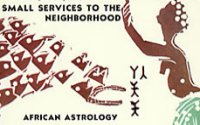|
|
|
 |

Ancestral African AstrologyWhen the term "astrology" is mentioned, minds often conjure images of zodiac signs like Aries or Libra, and planetary alignments charted by ancient Greeks or Babylonians. However, across the vast and culturally rich continent of Africa, a distinct and equally profound system of understanding human nature and destiny has flourished for millennia. Traditional African Astrology, unlike its Western or Vedic counterparts, is deeply rooted in the rhythms of nature, the wisdom of ancestral spirits, and the powerful symbolism of animal totems and natural phenomena. It offers a unique lens through which to explore individual characteristics, life paths, and community roles, emphasising interconnectedness rather than individual fate in isolation.
Unlike systems heavily reliant on precise planetary positions at the moment of birth, African astrology often places greater emphasis on the period of birth, connecting individuals to specific totems, elements, and archetypes prevalent during that time. It's less about predicting fixed outcomes and more about understanding an individual's innate strengths, weaknesses, and their inherent connection to the natural world and their community. At its heart, Traditional African Astrology delves into the essence of a person's spirit and their purpose within the collective. It perceives humans as microcosms of the universe, intricately linked to the macrocosm of the cosmos, the animal kingdom, and the ancestral realm. The "houses" or "signs" in this system are not abstract constellations but tangible aspects of the African landscape and its inhabitants: trees, animals, natural events, and human archetypes. These astrological periods, often aligned with lunar cycles or seasonal changes, reveal not only personality traits but also life lessons, potential challenges, and spiritual gifts. The ultimate aim is holistic well-being – guiding individuals to live in harmony with themselves, their community, and the natural world, thereby fulfilling their pre-ordained destiny and contributing positively to the flow of life. Traditional African Astrology serves as more than a predictive tool; it is a framework for self-understanding, spiritual guidance, and communal harmony. It's used to illuminate an individual's strengths and challenges, understand compatibility in relationships, and make informed life decisions. Guidance from diviners or elders, who interpret these signs, helps individuals align with their true purpose, connect with their ancestral lineage, and navigate life's complexities with wisdom and grace. It forms an integral part of holistic well-being, influencing rituals, ceremonies, and daily life. In an increasingly globalised world, the oral traditions of African astrology face challenges. However, there is a growing movement, both within Africa and globally, to document, preserve, and share these intricate systems. This effort ensures that the profound wisdom embedded in these astrological traditions continues to guide future generations, bridging the ancient past with the modern present. African astrology signs are read by the throwing of bones that form lines and arrows. The tracing made by these lines/arrows is organised by the diviner in three stories. The lower floor of the geomantic figures can be made by one to three vertical lines. For the two other levels (median and superior), the choice is binary, one or two lines. Thus, the total possible for the three levels of figures is twelve (3x2x2). Each of them has a name corresponding to the precise combination of figures as drawn on each individual profile. |






 Traditional African Astrology is not a monolithic system but rather a diverse collection of spiritual tenets and divinatory practices passed down through generations, primarily via oral tradition. While specific interpretations and symbols may vary from one ethnic group to another – be it the Yoruba of West Africa, the Zulu of Southern Africa, or the ancient Egyptians of North Africa – a common thread weaves them together: a profound respect for the Earth, an understanding of cyclical time, and a belief in the guidance of ancestors and spirit guides.
Traditional African Astrology is not a monolithic system but rather a diverse collection of spiritual tenets and divinatory practices passed down through generations, primarily via oral tradition. While specific interpretations and symbols may vary from one ethnic group to another – be it the Yoruba of West Africa, the Zulu of Southern Africa, or the ancient Egyptians of North Africa – a common thread weaves them together: a profound respect for the Earth, an understanding of cyclical time, and a belief in the guidance of ancestors and spirit guides.


